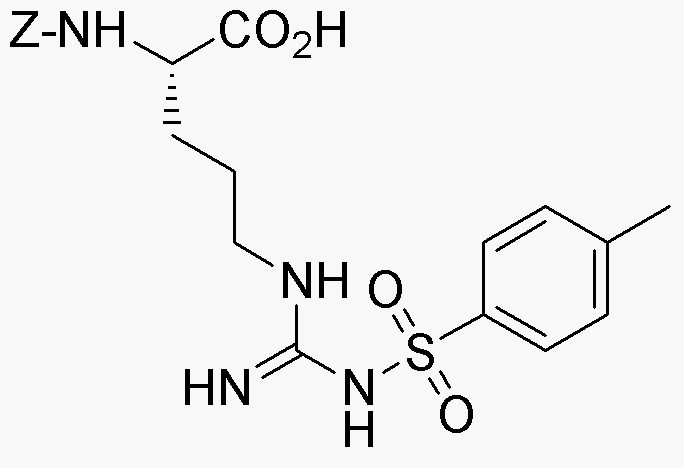Na-Z-Nw-(4-toluenesulfonyl)-L-arginine is widely utilized in research focused on:
- Biochemical Research: This compound serves as a valuable tool in studying protein interactions and enzymatic activities, particularly in the field of enzymology.
- Drug Development: It plays a role in the design of novel therapeutics, especially in targeting specific enzymes related to diseases, enhancing drug efficacy.
- Diagnostic Applications: Used in the development of assays for detecting specific biomolecules, aiding in early disease diagnosis and monitoring.
- Peptide Synthesis: This chemical is integral in synthesizing peptides with specific functionalities, which are crucial in various biological applications.
- Pharmaceutical Formulations: It can be incorporated into formulations to improve the solubility and stability of active pharmaceutical ingredients, thus enhancing their performance.
Informations générales
Propriétés
Sécurité et réglementation
Applications
Na-Z-Nw-(4-toluenesulfonyl)-L-arginine is widely utilized in research focused on:
- Biochemical Research: This compound serves as a valuable tool in studying protein interactions and enzymatic activities, particularly in the field of enzymology.
- Drug Development: It plays a role in the design of novel therapeutics, especially in targeting specific enzymes related to diseases, enhancing drug efficacy.
- Diagnostic Applications: Used in the development of assays for detecting specific biomolecules, aiding in early disease diagnosis and monitoring.
- Peptide Synthesis: This chemical is integral in synthesizing peptides with specific functionalities, which are crucial in various biological applications.
- Pharmaceutical Formulations: It can be incorporated into formulations to improve the solubility and stability of active pharmaceutical ingredients, thus enhancing their performance.
Documents
Fiches de données de sécurité (FDS)
La FDS fournit des informations de sécurité complètes sur la manipulation, le stockage et l’élimination du produit.
Spécifications du produit (PS)
Le PS fournit une description complète des propriétés du produit, notamment sa composition chimique, son état physique, sa pureté et les exigences de stockage. Il détaille également les plages de qualité acceptables et les applications prévues du produit.
Certificats d'analyse (COA)
Recherchez des certificats d'analyse (COA) en saisissant le numéro de lot du produit. Les numéros de lot et de lot se trouvent sur l'étiquette d'un produit, après les mots « Lot » ou « Lot de fabrication ».
Numéro de catalogue
Numéro de lot/série
Certificats d'origine (COO)
Ce certificat d'exploitation confirme le pays dans lequel le produit a été fabriqué, et détaille également les matériaux et composants utilisés et s'il est issu de sources naturelles, synthétiques ou autres sources spécifiques. Ce certificat peut être requis pour les douanes, le commerce et la conformité réglementaire.
Numéro de catalogue
Numéro de lot/série
Fiches de données de sécurité (FDS)
La FDS fournit des informations de sécurité complètes sur la manipulation, le stockage et l’élimination du produit.
DownloadSpécifications du produit (PS)
Le PS fournit une description complète des propriétés du produit, notamment sa composition chimique, son état physique, sa pureté et les exigences de stockage. Il détaille également les plages de qualité acceptables et les applications prévues du produit.
DownloadCertificats d'analyse (COA)
Recherchez des certificats d'analyse (COA) en saisissant le numéro de lot du produit. Les numéros de lot et de lot se trouvent sur l'étiquette d'un produit, après les mots « Lot » ou « Lot de fabrication ».
Numéro de catalogue
Numéro de lot/série
Certificats d'origine (COO)
Ce certificat d'exploitation confirme le pays dans lequel le produit a été fabriqué, et détaille également les matériaux et composants utilisés et s'il est issu de sources naturelles, synthétiques ou autres sources spécifiques. Ce certificat peut être requis pour les douanes, le commerce et la conformité réglementaire.


